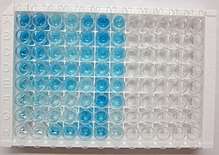Bioassay
A bioassay is an analytical method to determine concentration or potency of a substance by its effect on living cells or tissues.[1] Bioassays are quantitative biological assays used to estimate the potency of agents by observing their effects on living animals (in vivo) or tissue/cell culture systems (in vitro).[2]

A bioassay experiment can either be qualitative or quantitative, direct or indirect.[3] If the measured response is binary, the assay is qualititative, if not, it is quantitative.[3]
Bioassay is used to detect biological hazards or give a quality assessment of a mixture.[4] Bioassay is often used to monitor water quality and also sewage discharge and its impact on surrounding. It is also used to assess the environmental impact and safety of new technologies and facilities.
Principle
Bioassay is a biochemical test to estimate the relative potency of a sample compound to a standard compound.[3][1] Typical bioassay involves a stimulus (ex. drugs) applied to a subject (ex. animals, tissues, plants) and a response (ex. death) of the subject is triggered and measured.[5] The intensity of stimulus is varied by doses and depending on this intensity of stimulus, a change/response will be followed by a subject.[5].
History
The first uses of bioassay dates back to as early as the late 19th century, when the foundation of bioassays was laid down by a German physician, Paul Ehrlich.[6] He introduced the concept of standardization by the reactions of living matter.[6][5] His bioassay on diphtheria antitoxin was the first bioassay to receive recognition.[7] His use of bioassay was able to discover that administration of gradually increasing dose of diphteria in animals stimulated production of antiserum.[8]
Many of the early bioassays consisted of using animals to test carcinogenicity of chemicals.[9] One well known example is a "canary in the coal mine" experiment.[10] To test for methane, miners would take methane-sensitive canaries to coal mines to ensure safe air. In 1915, Yamaigiwa Katsusaburo and Koichi Ichikawa tested the carcinogenicity of coal tar using inner surface of rabbit's ears.[9]
Through 1940s and 1960s, animal bioassay was primarily used to test for toxicity and safety of drugs, food additives and pesticides.[9]
In late 1960s and 1970s, reliance on bioassay increased as the public concern for occupational and environmental hazards increased.[9] While before this health risks of certain chemicals such as pesticide was tested in animal bioassay, it was still rare and testing was not seen often.[9]
Classifications
Direct assay
- The stimulus/standard sufficiently produces measurable and specific response.[5] The response must be clear, easily recognized, and directly measured.[5]
Indirect assay based on quantitative response
- The relationship between the dose and the response is first ascertained.[5] Then the dose corresponding to a given response is obtained from the relation for each preparation separately.[5]
Indirect assay based on quantal response
- The assay involves 'all or none' response (ex. life or death). The response is produced by threshold effect.
Examples
ELISA (Enzyme-linked immunosorbent assay)
- quantitative analytical method that measures absorbance of color change from antigen-antibody reaction (ex. Direct, indirect, sandwich, competitive).[11] ELISA is used to measure variety of substances in human body from cortisol levels for stress to glucose level for diabetes.
Home pregnancy test
Home pregnancy test involves ELISA to detect the increase of human chorionic gonadotropin (hCG) during pregnancy.[12]
HIV test
HIV test also uses indirect ELISA to detect HIV antibody caused by infection.[12]
See also
References
- Hoskins, W. M.; Craig, R. (1962-01-01). "Uses of Bioassay in Entomology". Annual Review of Entomology. 7 (1): 437–464. doi:10.1146/annurev.en.07.010162.002253. ISSN 0066-4170. PMID 14449182.
- Guidance for Industry: Potency Tests for Cellular and Gene Therapy Products, Food and Drug Administration, January 2011, p. 7
- Laska, E M; Meisner, M J (1987-04-01). "Statistical Methods and Applications of Bioassay". Annual Review of Pharmacology and Toxicology. 27 (1): 385–397. doi:10.1146/annurev.pa.27.040187.002125. ISSN 0362-1642.
- Prinsloo, Gerhard; Papadi, Georgia; Hiben, Mebrahtom G.; Haan, Laura de; Louisse, Jochem; Beekmann, Karsten; Vervoort, Jacques; Rietjens, Ivonne M.C.M. (2017). "In vitro bioassays to evaluate beneficial and adverse health effects of botanicals: promises and pitfalls". Drug Discovery Today. 22 (8): 1187–1200. doi:10.1016/j.drudis.2017.05.002.
- Saha, G. M (29 November 2002). Design and Analysis for Bioassays. Kolkata: Indian Statistical Institute. pp. 61–76.
- Van Noordwijk, Jacobus (1989). "Bioassays in whole animals". Journal of Pharmaceutical and Biomedical Analysis. 7 (2): 139–145. doi:10.1016/0731-7085(89)80077-9.
- Analysis of foods and beverages : modern techniques. Charalambous, George, 1922-1994. Orlando: Academic Press. 1984. ISBN 0121691608. OCLC 9682930.CS1 maint: others (link)
- Bosch, Fèlix; Rosich, Laia (2008). "The Contributions of Paul Ehrlich to Pharmacology: A Tribute on the Occasion of the Centenary of His Nobel Prize". Pharmacology. 82 (3): 171–179. doi:10.1159/000149583. ISSN 0031-7012. PMC 2790789. PMID 18679046.
- Beyer, L. A.; Beck, B. D.; Lewandowski, T. A. (2011-04-01). "Historical perspective on the use of animal bioassays to predict carcinogenicity: Evolution in design and recognition of utility". Critical Reviews in Toxicology. 41 (4): 321–338. doi:10.3109/10408444.2010.541222. ISSN 1040-8444. PMID 21438739.
- "Environmental Inquiry - How Are Bioassays Used in the Real World?". ei.cornell.edu. Retrieved 2017-12-01.
- Aydin, Suleyman (2015). "A short history, principles, and types of ELISA, and our laboratory experience with peptide/protein analyses using ELISA". Peptides. 72: 4–15. doi:10.1016/j.peptides.2015.04.012. PMID 25908411.
- Manz, Andreas; Dittrich, Petra S.; Pamme, Nicole; Iossifidis, Dimitri (2015). Bioanalytical chemistry. Manz, A. (Andreas), Dittrich, Petra S., 1974-, Pamme, Nicole., Iossifidis, Dimitri. (Second ed.). London. ISBN 9781783266715. OCLC 897825792.